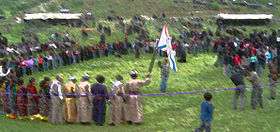Kha b-Nisan
| Kha b' Nisan | |
|---|---|
 Kha b' Nisan celebration in Nahla region | |
| Official name | Syriac: ܚܕ ܒܢܝܣܢ |
| Observed by | Assyrian people |
| Type | Cultural |
| Celebrations | Dancing circles, parades, picnics |
| Date | 1 April |
| Next time | 1 April 2017 |
| Related to | Akitu, Seharane, Noruz |
Kha b' Nisan or Ha b' Nisin,[1] also Ha b' Nison; ܚܕ ܒܢܝܣܢ "First of April", Resha d'Sheta; ܪܫܐ ܕܫܢܬܐ "Head of the year" in Assyrian, also known as Akitu, or Assyrian New Year[2] is the spring festival among the Assyrians, celebrated on 1 April.
Celebrations involve parades and parties. Some Assyrians wear traditional costume and dance in parks for hours. In Europe, the United States and Canada, there are often parties with food, music and dance.[3]
History
In the Julian calendar, the vernal equinox moved gradually away from 21 March. The Gregorian calendar reform restored the vernal equinox to its original date, but since the festival was by now tied to the date, not the astronomical event, Kha b' Nisan remains fixed at 21 March in the Julian reckoning, corresponding to 1 April in the Gregorian calendar. The Vernal equinox is celebrated throughout Greater Iran as Noruz meaning "New Day" on 21 March. However, in the ancient Assyrian and Babylonian traditions, the spring festival was celebrated in the first days of the month known as "Nisan"[4] and the calendar adopted by the ancient Assyrians had the month "Nisan" at the beginning of the calendar[5] lending to the term "Kha b' Nisan", or the "first of Nisan".
In the 1950s, rising interest in Assyrianism resulted in the creation of an official "Assyrian calendar" with its era fixed at 4750 BC, inspired by an estimate of the date of the first temple at Ashur in the Middle Ubaid period. In the same spirit, the Akkadian name of the spring festival, Akitu, was revived. It is essential to consider that the Assyrian people have generally celebrated Akitu on the first day of April since 4750 BC and that a creation of an official calendar would aim to unite the Assyrians in their nationalism.
The event is also largely celebrated by Assyrians residing in Syria. Although the Syrian government does not acknowledge the festival, Assyrians still continue with the celebration.[6] In 2002, Assyrians in Syria celebrated the event with a mass wedding of 16 couples and over 25,000 attendees.[7] After the formation of Turkey, Kha b' Nisan along with the Nowruz were banned from public to celebrate. Assyrians in Turkey were first allowed to publicly celebrate Kha b' Nisan in 2005, after organisers received permission from the government to stage the event, in light of democratic reforms adopted in support of Turkey's EU membership bid.[8][9] Around 5,000 people "including large groups of visiting ethnic Assyrians from Europe, Syria and Iraq" took part in the Kha b' Nisan celebrations.[10]
One of the largest Assyrian New Year celebration took place in Iraq in 2008. Public celebrations were not allowed by Saddam Hussein's regime prior to the start of the Iraq war. The event was organized by the Assyrian Democratic Movement and between 45,000 and 65,000 people took part in the parade.[11][12]
In 2004, Hon. George Radanovich of the California State Assembly recognized the Assyrian New Year and extended his wishes to the Assyrian community in California.[13] This was later followed by a letter from the California governor, Arnold Schwarzenegger, to the Assyrian community in California congratulating them on the annual celebration.[14]
Celebration
Assyrians celebrate Kha b' Nisan by holding social events including parades and parties. They also gather in clubs and social institutions and listen to the poets who recite the story of creation. The men and women wear traditional clothes and dance in parks for hours.
It has also become tradition to hold a parade down King Sargon Blvd in Chicago, Illinois,[15] with the Assyrian organizations, churches, and sometimes businesses, each creating a float and participating in the parade.
It is a tradition in Assyrian villages for girls to gather flowers and herbs which are then suspended under the house's roof. The bunches are referred to as "Deqna d' Nisan",[16] ܕܩܢܐ ܕܢܝܣܢ meaning "beard of April/Spring".
Image gallery
-

Chaldean Church float in Assyrian New Year parade in Chicago, IL.
See also
References
- ↑ AUA Release 26 March 2006.
- ↑ Michael Chammas. "Assyrian new year". Fairfield Champion. 26 March 2008.
- ↑ Aimie Rivera. "Assyrians celebrate new year". The Signal. 3/19/08.
- ↑ E. Elochukwu Uzukwu. Worship as Body Language: Introduction to Christian Worship : an African. Published by Liturgical Press, 1997.
- ↑ William Ricketts Cooper. "An Archaic Dictionary: biographical, historical and mythological: from the Egyptian, Assyrian, and Etruscan monuments". Published by S. Bagster and Sons, 1876.
- ↑ http://www.unhcr.org/refworld/topic,463af2212,46ef83f52,4959de172,0.html
- ↑ http://www.bethsuryoyo.com/currentevents/6752HomelandCelebration/CelebrationInSyria.html
- ↑ Assyrians Celebrate New Year for First Time in Turkey (SETimes.com)
- ↑ Erkan's field diary:
- ↑ NYT (4 April 2005)
- ↑ http://www.helentalia.com/community.htm
- ↑ http://www.zindamagazine.com/html/archives/2008/04.14.08/index_mon.php#goodmorningassyria
- ↑ Congressional Records – Extensions of Remarks
- ↑ Governor's letter to Assyrian community
- ↑ April 2005
- ↑ Ashor Giwargis. Al-Nahar Newspaper. Beirut, Lebanon. 14 April 2002.
External links
- Akitu and Newruz (aina.org)
- Kurd's – Persian New Year; its Assyrian – Babylonian origin (christiansofiraq.com)
- Assyrian NewYear 6758 Ceremony In Tehran (brasheet.com)
- Assyrian NewYear 6758 Ceremony In Urmia (brasheet.com)
